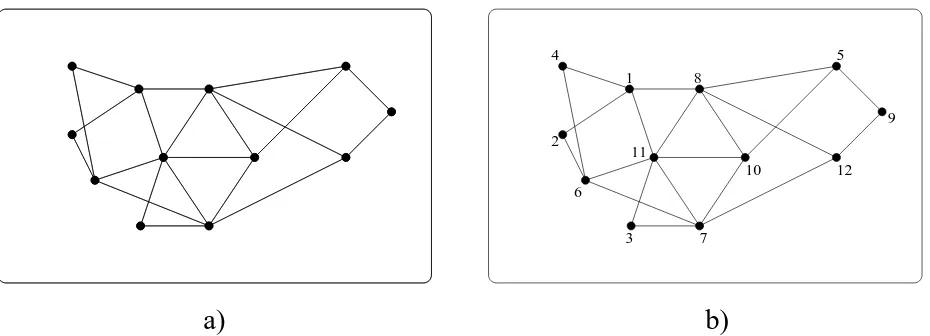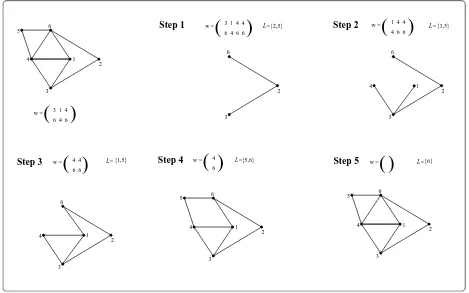23 11
Article 04.3.1
Journal of Integer Sequences, Vol. 7 (2004), 2
3 6 1 47
The Number of Labelled
k
-Arch Graphs
C´
edric Lamathe
LORIA - INRIA Lorraine
Campus Scientifique, B.P. 239
54506 Vandoeuvre-l`
es-Nancy Cedex, France
[email protected]
Abstract
In this note, we deal with k-arch graphs, a generalization of trees, which contain k-trees as a subclass. We show that the number of vertex-labelledk-arch graphs with n vertices, for a fixed integer k ≥ 1, is ¡n
k
¢n−k−1
. As far as we know, this is a new integer sequence. We establish this result with a one-to-one correspondence relating
k-arch graphs and words whose letters are k-subsets of the vertex set. This bijection
generalises the well-known Pr¨ufer code for trees. We also recover Cayley’s formula
nn−2 that counts the number of labelled trees.
1
Introduction
We recursively define the class of k-arch graphs, for k ≥ 1, as the smallest class of simple graphs such that:
1. a (k−1)-simplex (i.e., a complete graph on k vertices) is a k-arch graph;
2. if a simple graph G has a vertex v of degree k such that the graph G− {v} obtained from G by removing v and its incident edges is a k-arch graph, then G is a k-arch graph.
b)
Figure 1: Arch graphs on 12 vertices a) unlabelled, b) vertex-labelled.
graphs, calledk-trees, studied since the later 1960’s. The essential difference betweenk-trees and k-arch graphs lie in the fact that for k-trees, we assume that the vertex v is attached to k mutually adjacent vertices (that is, it forms a complete graph on k+ 1 vertices). For instance, see [4,13] for the labelled enumeration ofk-trees, and [3,14] for the particular case
k = 2. Harary and Palmer [7] treat the unlabelled enumeration as well as Fowler et al. [6], who provide in addition asymptotic formulas. We also mention [8,5] for the enumeration of generalizations of 2-trees and [10], where various specializations of 2-trees are enumerated. Finally, Labelle et al. [9] propose a classification of outerplanar 2-trees according to their symmetries. Althoughk-trees have been extensively studied, unlabelled enumeration of these structures is still an open problem. Apart from enumerative aspects of 2-trees, Leclerc and Makarenkov [12] give a correspondence between tree functions and 2-trees in the framework of tree metrics and tree dissimilarities (see [1,2]).
In [18, 11], k-arch graphs are defined as maximal kd-acyclic graphs, where a graph is said kd-acyclic, if it contains no kd-cycle (see [11], definition 3.1). Todd shows that this definition is equivalent to the recursive one given above. Leclerc uses valuated arch graphs (that is, arch graph with valuated edges) to encode tree distances or tree functions (see [1,2]).
We recall that the number of labelled k-trees overn vertices is given by ([4, 13])
akn=
The aim of this note is to obtain the number of labelled k-arch graphs. We show this number is
vertex labels. This correspondence generalizes the Pr¨ufer code for trees ([15]).
2
The number of labelled
k
-arch graphs
In this section, we establish a formula giving the number of labelledk-arch graphs, fork ≥1. We prove this formula using a bijective argument based on a generalization of the Pr¨ufer code for vertex-labelled Cayley trees ([15]) which has been generalized for k-trees ([16]). Note that formula (2) first appear (without proof) in the conclusion of [10].
We call leaf of a k-arch graph, a vertex of degree k. For instance, in Figure 1 b), there are four leaves, respectively labelled 2,3,4,9. This definition of leaf is legitimate since, for the special casek = 1, a vertex of degree one in a Cayley tree is a leaf, in the common sense of graph theory.
Proposition 1 Let k ≥ 1 be a fixed integer. Then, the number Gk
n of k-arch graphs over n labelled vertices, for n > k, is given by
Gk
Proof. We construct a one-to-one correspondence between k-arch graphs on n labelled vertices and wordsw=w1w2. . . wn−k−1 of lengthn−k−1 where eachwi is a (valid)k-letter
Such words are calledvalid. We implicitly assume that an order is given on the labels, i.e.,
v1 < v2 < . . . < vn. The one-to-one correspondence works by successive leaf deletions. Let
g be a k-arch graph on n vertices with vertex set V ={v1, v2, . . . , vn}. At the first step, we choose the leaf with the smallest label ing, we remove it from g as well as its incident edges and form ak-letter with its adjacent vertices by ordering them in increasing order. The fact that the degree of a leaf is k and the vertex ordering ensure we can always form a unique validk-letter. After the first leaf deletion, we obtain ak-arch graph with n−1 vertices and we repeat the first step. Repeating this step n−k−1 times, we get a valid word of length
that is, a complete graph on k vertices. For instance, if we apply this construction to the arch graph of Figure1 b), we obtain the following valid word of length 9:
µ
1 7 1 8 7 5 8 8 10 6 11 6 11 11 12 10 7 11
¶
. (4)
Conversely, given a valid wordw=w1w2. . . wn−k−1 of lengthn−k−1, we want to construct ak-arch graph withn labelled vertices. Together withw, we use a dynamic subsetL of the vertex setV, that is, a subset with evolving entries and size. At the beginning, we fillLwith all vertices not appearing in w and we extend w by appending a copy of the last k-letter,
wn−k−1, at the end ofw. We also denote w this extended word
w:=w||wn−k−1 =w1w2. . . wn−k−1wn−k−1.
For instance, according to the labelledk-arch graph of Figure1b), we obtainL={2,3,4,9}
and w becomes µ
1 7 1 8 7 5 8 8 10 10 6 11 6 11 11 12 10 7 11 11
¶
.
We remove the smallest element ofLand join it to every entry of the firstk-letter (w1) ofw. We then deletew1 from wand still call w this reduced word. We update Lby adding every vertex vi ∈ w1 not appearing in the remaining letters of w. We repeat the above recursive step with the word w = w2. . . wn−k−1wn−k−1, and so on until we reach the empty word, keeping at each step the connected component created. To end the converse map, we have to connect together the k vertices of the lastk-letter wn−k−1 of w.
We have to verify that we obtain a connected graph which is a k-arch graph corresponding to the word w when the leaf deletion algorithm is applied. It is quite straightforward using a recursive argument, as the reader can check.
Figure 2 shows a complete example of the reverse map for a labelled arch graph of six vertices.
Remark 1 It is interesting to note that, for k= 1, formula (2) remains valid. Indeed, this formula becomes Cayley formula (an =nn−
2
) enumerating trees with n labelled vertices.
Remark 2 The converse map constructed in the proof of Proposition 1 induces easily an algorithm of random generation of labelled k-arch graphs by means of valid words.
3
Conclusion
The following table gives the first few values of the number ofk-arch graphs over n labelled vertices, for k from 1 up to 7, and for n from k up to 10. Only the first line of this table (corresponding to Cayley formulaan=nn−
2
1
Figure 2: Illustration of the reverse map.
In this note, we showed by a bijective way that the number of labelled k-arch graphs is given by a new integer sequence. The class of k-arch graphs are a natural multidimensional generalization of trees, encompassing k-trees. To go further in the study of k-arch graphs, we have to wonder about the unlabelled enumeration of these graphs. Unfortunately, no result is known about the unlabelled enumeration of both k-arch graphs and k-trees.
k\n 1 2 3 4 5 6 7 8 9 10
1 1 1 3 16 125 1296 16807 262144 4782969 100000000 2 - 1 1 6 100 3375 194481 17210368 2176782336 373669453125 3 - - 1 1 10 400 42875 9834496 4182119424 2985984000000 4 - - - 1 1 15 1225 343000 252047376 408410100000 5 - - - - 1 1 21 3136 2000376 4032758016
6 - - - 1 1 28 7056 9261000
7 - - - 1 1 36 14400
Table 1: Values of Gk
4
Acknowledgments
We greatly thank Bruno Leclerc for his presentation ofk-arch graphs in a Montreal seminar (LaCIM seminar, Universit´e du Qu´ebec `a Montr´eal) and Pierre Leroux for useful discussions.
References
[1] J. P. Barth´elemy et A. Gu´enoche, Les Arbres et les Repr´esentations des Proximit´es, Masson, 1988.
[2] J. P. Barth´elemy and A. Gu´enoche, Trees and Proximity Representations, Wiley-Interscience Series in Discrete Mathematics and Optimization, 1991.
[3] L. W. Beineke and J. W. Moon, Several proofs of the number of labeled 2-dimensional trees, in F. Harary ed., Proof Techniques in Graph Theory, Academic Press, 1969, pp. 11–20.
[4] L. W. Beineke and R. Pippert, The number of labeledk-dimensional trees, J. Combin. Theory6 (1969), 200–205.
[5] M. Bousquet and C. Lamathe, Enumeration of solid 2-trees, in Proceedings of the 14th international conference Formal Power Series and Algebraic Combinatorics (FPSAC’02), 2002, pp. 133–147.
[6] T. Fowler, I. Gessel, G. Labelle, P. Leroux, The specification of 2-trees, Adv. in Appl. Math. 28 (2002), 145–168.
[7] F. Harary and E. Palmer,Graphical Enumeration, Academic Press, 1973.
[8] G. Labelle, C. Lamathe and P. Leroux, Labelled and unlabelled enumeration ofk-gonal 2-trees,J. Combin. Theory Ser. A 106 (2004), 193–219.
[9] G. Labelle, C. Lamathe and P. Leroux, A classification of plane and planar 2-trees,
Theoret. Comput. Sci. 307 (2003), 337–363.
[10] C. Lamathe, Sp´ecification de classes de structures arborescentes, Ph.D. dissertation, Universit´e du Qu´ebec `a Montr´eal, (2003).
[11] B. Leclerc, Graphes d’arches, Math. & Sci. humaines 157 (2002), 27–48.
[12] B. Leclerc and V. Makarenkov, On some relations between 2-trees and tree metrics,
Discrete Math. 192 (1998), 223–249.
[13] J. W. Moon, The number of labeled k-trees, J. Combin. Theory 6 (1969), 196–199.
[14] E. Palmer, On the number of labeled 2-trees,J. Combin. Theory 6 (1969), 206–207.
[16] C. R´enyi and A. R´enyi, The Pr¨ufer code for k-trees, in Combinatoral theory and it’s applications (Proc. Colloq. Balatonf¨ured, 1969), North-Holland, 1970, pp. 945–971.
[17] N. J. A. Sloane and S. Plouffe,The Encyclopedia of Integer Sequences, Academic Press, 1995. http://www.research.att.com/∼njas/sequences
[18] P. Todd, Ak-tree generalization that characterizes consistency of dimensioned engineer-ing drawengineer-ings, SIAM J. Disc. Math.2 (1989), 255–261.
2000 Mathematics Subject Classification: Primary 05A15, 05C30; Secondary 05A10.
Keywords: k-arch graphs, Pr¨ufer code, generalization of trees.
(Concerned with sequences A000272,A098721, A098721,A098723 and A098724.)
Received December 22 2003; revised version received July 1 2004. Published in Journal of Integer Sequences, August 2 2004. Minor revision (to add new sequences), March 16 2005.

